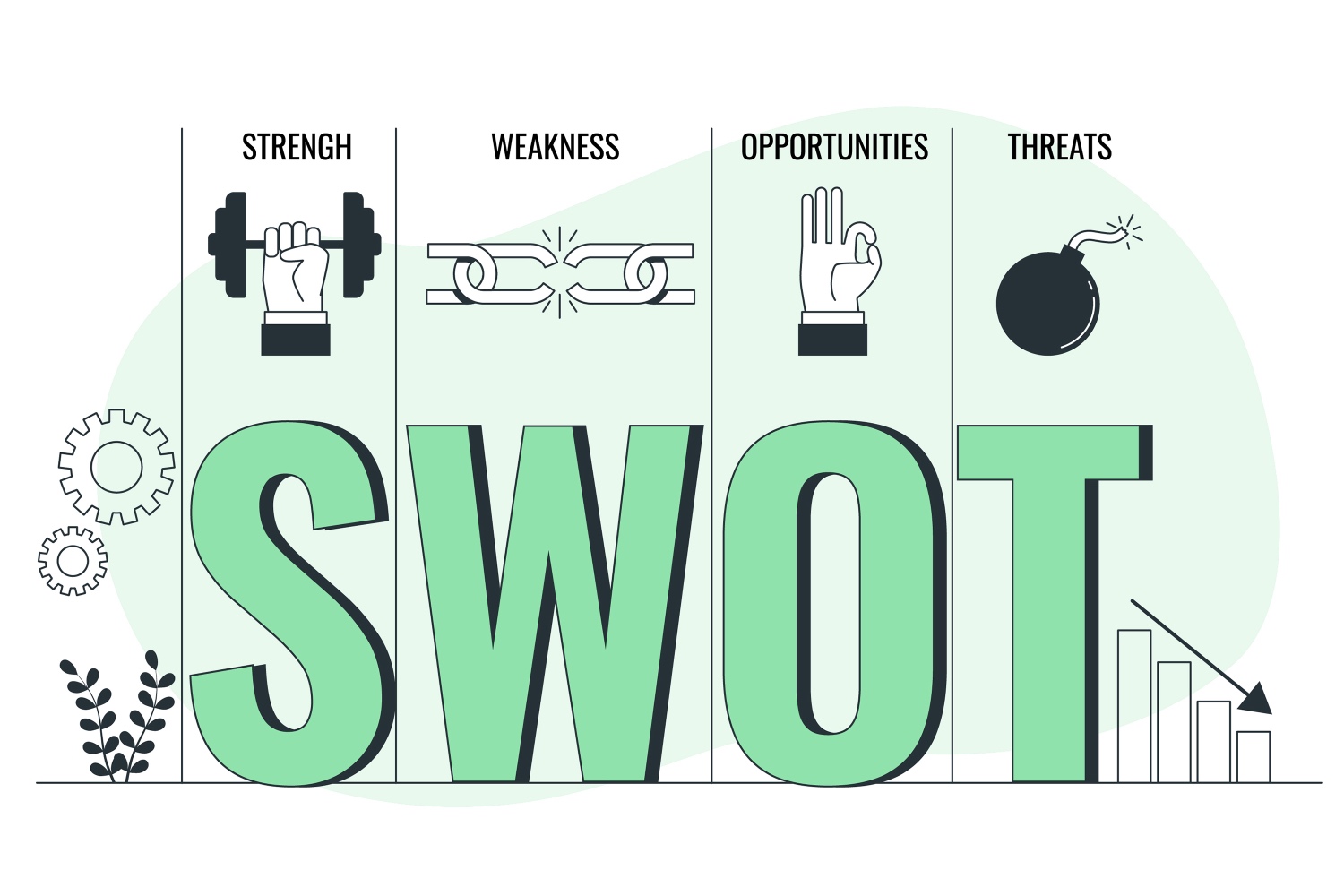
In today’s fast-paced business environment, staying ahead of the competition is crucial for success. A competitive analysis is a powerful tool that helps businesses understand the market, their competition, and their strengths and weaknesses. This comprehensive guide will walk you through the process of conducting a competitive analysis and provide the information you need to make informed decisions about your business.
What Is Competitive Analysis
Competitive analysis is researching and evaluating your business’s strengths, weaknesses, opportunities, and threats compared to your competitors. A competitive study aims to understand your industry’s competitive landscape and identify areas where you can differentiate your business and gain a competitive advantage.
The competitive analysis typically involves the following steps:
- Identify your competitors. This consists in researching and listing businesses that offer similar products or services to your own.
- Conduct a SWOT analysis. This involves evaluating your business’s strengths, weaknesses, opportunities, and threats compared to your competitors.
- Study your competitors’ marketing strategies. This involves researching and analyzing your competitors’ marketing tactics and strategies, such as advertising, promotions, and branding.
- Analyze your competitors’ online presence. This involves researching and evaluating your competitors’ websites, social media presence, SEO, and online advertising efforts.
- Gather customer feedback and market insights. This involves collecting feedback from existing customers and conducting market research to gain insights into the market and customer preferences.
Competitive analysis is an essential aspect of business strategy and can help you understand the market, stay ahead of your competitors, and make informed decisions about your business.
Define Your Competitors
The first step in conducting a competitive analysis is identifying your competitors. Direct competitors are companies that offer the same products or services as you, while indirect competitors offer similar products or services but target different customer segments. Consider industry, location, and target audience.
Defining your competitors is an essential step in conducting a competitive analysis. Competitors can be both direct and indirect, and it is crucial to identify both to understand the market comprehensively.
Direct competitors offer the same products or services as your business. For example, if you run a clothing store, your direct competitors would be other clothing stores that offer similar products and target the same customer base.
Indirect competitors, on the other hand, offer similar products or services but target a different customer segment. For example, if you run a high-end clothing store, your indirect competitors may be discount clothing stores that offer cheaper products but target a different demographic.
To define your competitors, consider industry, location, and target audience. Market research and gathering information about your competitors will help you make informed decisions about your business strategy and stay ahead of the competition.
Why Create a Competitive Analysis for Your Business
There are several reasons why creating a competitive analysis for your business is essential:
- Better Understanding of the Market. Competitive analysis helps you better understand your industry, including the players in the market, their strengths and weaknesses, and their overall approach to the market.
- Improved Decision Making. By analyzing your competitors and the market, you can make informed decisions about your business strategy, including product offerings, marketing efforts, and overall approach to the market.
- Stay Ahead of the Competition. Competitive analysis helps you stay ahead by providing insights into what is working in the market and what customers are looking for.
- Identify Areas of Opportunity. By understanding your competitors and the market, you can identify areas where there are gaps in the market that you could potentially fill, allowing you to differentiate your business and gain a competitive advantage.
- Better Allocate Resources. By knowing what your competitors are doing and what is working in the market, you can better allocate your resources and focus on what will drive the most results for your business.
- Monitor Industry Trends: A competitive analysis helps you monitor industry trends and changes in the market, allowing you to stay ahead of the curve and adjust your business strategy as needed.
Overall, competitive analysis is an essential aspect of business strategy that can help you stay ahead of the competition, make informed decisions, and grow your business in the market.
SWOT Analysis

Once you have identified your competitors, the next step is to conduct a SWOT analysis. SWOT stands for Strengths, Weaknesses, Opportunities, and Threats. This analysis will help you understand the strengths and weaknesses of your business compared to your competitors and identify any opportunities and threats in the market.
SWOT Analysis is a strategic planning tool used to evaluate the Strengths, Weaknesses, Opportunities, and Threats of a business. It is a valuable tool for companies to understand their market position and competition.
Strengths refer to a business’s advantages, such as a unique product offering, strong brand recognition, or a talented team.
A business’s limitations or drawbacks include limited resources, outdated technology, or a weak market position.
Opportunities refer to external factors that can be leveraged to grow the business, such as changes in the market, new technology, or the introduction of new products.
Threats are external factors that may negatively impact the business, such as changes in the market, new competition, or regulations.
It is important to regularly conduct a SWOT analysis to stay updated on market changes and ensure that the business stays ahead of the competition. Conducting a SWOT analysis helps companies identify their strengths and weaknesses, opportunities and threats in the market. This information can then inform decision-making and create a successful business strategy.
Study Your Competitors’ Marketing Strategies
Understanding how your competitors are marketing their products or services is essential. This includes analyzing their advertising campaigns, promotions, and distribution channels. By understanding your competitors’ marketing strategies, you can identify opportunities to differentiate yourself and improve your marketing efforts.
Studying your competitors’ marketing strategies is essential in conducting a competitive analysis. This helps you understand how your competitors position themselves in the market and their marketing tactics to attract and retain customers.
To study your competitors’ marketing strategies, start by identifying their target audience and the message they are trying to convey. Look at their website, social media presence, and advertising materials to understand their brand image and messaging.
Next, examine the channels they are using to reach their target audience. Are they relying heavily on social media, email marketing, or paid advertising? Knowing how your competitors reach their target audience can help determine the channels you should focus on.
It’s also important to watch your competitors’ promotions and special offers. Are they offering discounts, special deals, or running promotions you could offer? Knowing your competitors’ actions can help you stay ahead of the game and create advertisements that stand out in the market.
Finally, analyze your competitors’ customer feedback and reviews. What are customers saying about their products or services? Are they happy with their experiences, or are there common complaints you could address in your business?
Studying your competitors’ marketing strategies will give you valuable insights into the market and help you make informed decisions about your marketing strategy. This can help you stay ahead of the competition and grow your business.
Analyze Your Competitors Online Presence
A strong online presence is crucial for businesses in today’s digital age. Analyze your competitor’s websites, social media presence, and online reviews to understand their online reputation and identify areas for improvement.
Analyzing your competitors’ online presence is crucial in conducting a competitive analysis. This helps you understand how your competitors leverage digital channels to reach their target audience and grow their business.
Start by conducting a thorough audit of your competitor’s websites. Look at their site’s design, user experience, and overall functionality. What are they doing well, and what could they improve upon? This will help you understand what you need to stand out.
What platforms are they active on, and what content are they posting? Are they focused on building a community, driving sales, or promoting their brand? Understanding how your competitors use social media can help you determine what platforms you should be active on and what content will be most effective for your business.
Your competitors’ SEO efforts can help you determine keywords and topics you should focus on in content creation. Understanding your competitors’ SEO strategy can help you decide what keywords and topics to focus on in content creation.
Finally, examine your competitors’ online advertising efforts. Are they running display ads, pay-per-click ads, or other online advertising to reach their target audience? Understanding how your competitors use online advertising can help you determine what types of advertising will be most effective for your business.
By analyzing your competitors’ online presence, you will gain valuable insights into the digital landscape of your industry and be better equipped to create a successful online marketing strategy for your business.
Gather Customer Feedback and Market Insights

Finally, gather customer feedback and market insights to understand what customers value and what they are looking for in your products or services. This information can be used to inform your business strategy and stay ahead of the competition.
Gathering customer feedback and market insights is crucial in conducting a competitive analysis. This helps you understand what customers are looking for and what they value in the market, as well as identify any gaps in the market that you could fill.
Start by reaching out to your existing customers and asking for their feedback. Ask them about their experiences with your products or services, what they like, and what they would like to see improved. This information can help you make informed decisions about your offerings and improve the customer experience.
Next, conduct market research to gain a deeper understanding of your target audience and the market as a whole. This can include surveys, focus groups, and competitor analysis to gather insights into what customers look for and value.
It’s also important to keep an eye on industry trends and changes in the market. This can include monitoring competitor activity, staying up-to-date on news and events, and following industry influencers and thought leaders.
Finally, gather data on your business performance and market trends. This can include tracking website traffic, sales data, and customer engagement metrics. This information can help you identify areas of opportunity and make informed decisions about the direction of your business.
You will better understand your target audience and the market by gathering customer feedback and market insights. This information can help you make informed decisions about your business strategy and continue to grow and succeed in the market.
Conclusion
In conclusion, conducting a competitive analysis is valuable for any business looking to stay ahead of the competition and grow in the market. By understanding your competitors, you can gain insights into what works in your industry and what customers seek. This information can help you make informed decisions about your business strategy, including your marketing efforts, product offerings, and overall approach to the market.
The competitive analysis involves several key steps, including defining your competitors, conducting a SWOT analysis, studying your competitors’ marketing strategies, analyzing your competitors’ online presence, and gathering customer feedback and market insights. By thoroughly analyzing your competitors and the market, you will be better equipped to develop a successful business strategy that sets you apart from the competition.